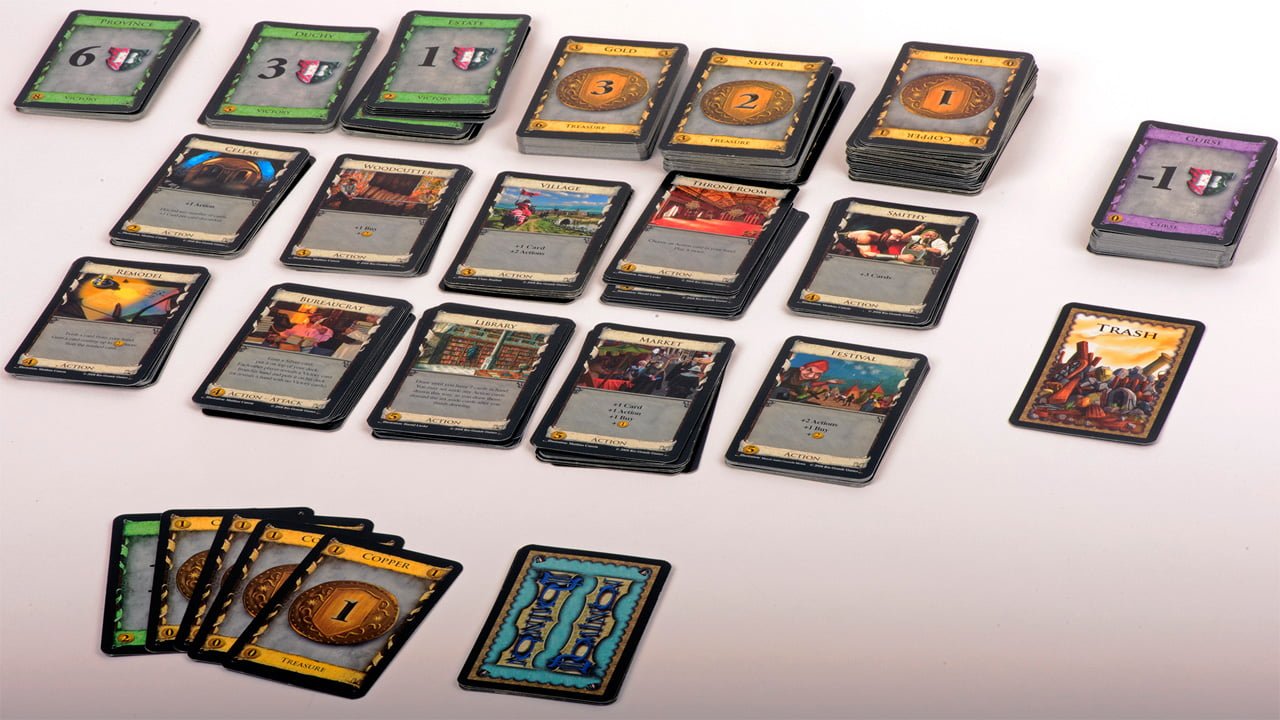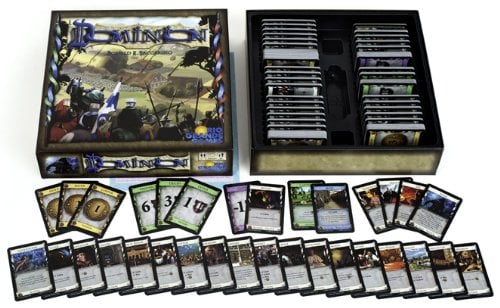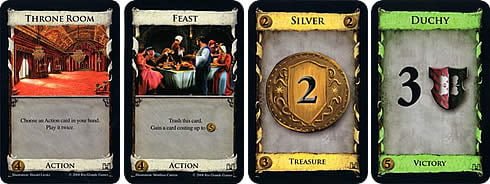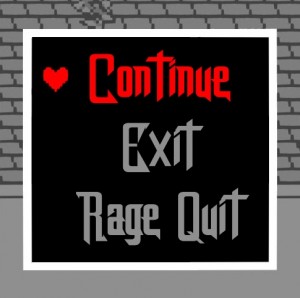
‘Dominion’ has been popular for a long time, and with good reason: it’s a resource-heavy deckbuilder, but the main twist is that the resources you use can be varied from game to game – think if you could play ‘Monopoly’ with different street spaces and special areas every game. This can be done with the basic game only, not requiring any expansions – although those do exist, too, for even greater variation and replayability.
The basic setup can seem a little daunting at first, but really is fairly easy. You have to begin by creating the Kingdom, a fairly elaborate “trade row” of cards that all players will be able to purchase from to build their decks as the game progresses. There are certain cards that you’ll include in every game you play: three different types of Treasure cards (Copper, Silver, and Gold each give 1, 2, or 3 points worth of buying power, respectively), three different types of Victory cards (Estates, Duchies, and Provinces each give 1, 3, or 6 end-game victory points respectively), and Curse cards (which take away end-game Victory points). The last type of cards to go into the Kingdom are Action cards – these are cards that each allow you to perform a different game-relevant when you play them out of your hands in subsequent turns. For example, the Smithy action card allows you to draw three additional cards. There are about 20 Action card types in the base set, so usually either players agree pre-game which Actions they’d like to play with, or each player chooses one or more Action that gets included in this particular game, until you’ve reached the 10-Action limit.
On each player’s turn, they will draw five cards and be able to play them – a player’s deck to start the game will include seven Copper cards and three Estate cards. Cards that are played and any cards that are purchased in a turn (usually a limit of one, unless an Action card that’s played allows for multiple purchases) go into the player’s discard pile, and the discard pile is shuffled and played once a player’s draw pile is exhausted. Gameplay continues until three different piles in the Kingdom have been completely exhausted OR the Province pile has been exhausted; at that point, players count up the total number of Victory Points on the cards they own (in their hands, draw pile, and discard pile), and he/she with the most points wins!

Abilities on the Action cards is really where a player can develop their strategy to help them win the game, so a moderate amount of reading and planning is involved. Each Action card may allow you to perform such moves like playing extra Actions on this turn, making extra purchases from the trade row, and giving you more money with which to purchase cards. There are also Action cards that have a bit more detail to them, such as allowing you to play another Action card twice, or even “attacking” your opponent by forcing them to discard, take a Curse card, etc. The strategy starts to develop as your personal deck grows; being able to play only one Action card per turn (prior to any Action card actions potentially helping you with that) can be a real challenge when you draw multiple Action cards in your hand. Additionally, you’ll need Victory points to win the game at the end… but during the game, almost every card that gives you said VP are totally worthless when they come up in your hand. It’s an intriguing dichotomy that can usually leave players in a “who will make the first move” scenario when it comes to “breaking the seal” of purchasing Victory cards.
It took me about three turns in my first game to get the sense of what I was doing and the strategy I wanted to mentally develop in order to approach the game – but once I got into the swing of things, the flow of the game starting coming very easily to me. A challenge for players not so familiar with deckbuilding games might be keeping track of everything you can do during a turn, and then actually doing your actions in the right order; it didn’t seem uncommon for some of us players to have 6-10 Actions played on any given turn as we progressed, since some cards allow you to both draw more cards and play multiple additional Actions. Sometimes it did become a challenge to keep track of it all.
All in all, however, the fact that you can play a new game right after you finished one game and have a completely different experience, by virtue of changing out one or more of the Action cards, makes this a game with high replay value – and the fact that it’s engaging and fun in it’s own right certainly helps as well. For me, it’s a solid Continue!
CONTINUE: a game you enjoy so much, you’d opt to keep playing more right away if you could!
The highest rating for a game.
Come back and visit us next week for another game to hear all about – if there are any games you like to play or that you’d like to see reviewed, please leave a comment below so we can connect with you!
![]() Tony Schaab mixed up all this fake puke at home and then he went to this movie theater, hid the puke in his jacket, climbed up to the balcony, and then he made a noise like this: hua-hua-hua-huaaaaaaa… and then he dumped it over the side, all over the people in the audience. And then – this was horrible – all the people started getting sick and throwing up all over each other… and he never felt so bad in his entire life! A lover of most things sci-fi and horror, Tony is an author by day and a DJ by night. Come hang out with Tony on Facebook and Twitter to hear him spew semi-funny nonsense and get your opportunity to finally put him in his place.
Tony Schaab mixed up all this fake puke at home and then he went to this movie theater, hid the puke in his jacket, climbed up to the balcony, and then he made a noise like this: hua-hua-hua-huaaaaaaa… and then he dumped it over the side, all over the people in the audience. And then – this was horrible – all the people started getting sick and throwing up all over each other… and he never felt so bad in his entire life! A lover of most things sci-fi and horror, Tony is an author by day and a DJ by night. Come hang out with Tony on Facebook and Twitter to hear him spew semi-funny nonsense and get your opportunity to finally put him in his place.



